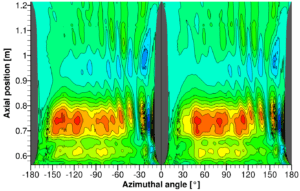Optimisation (Liner Optimisation)
Acoustic absorbers, so-called liners, are used in many technical areas in which noise development and the targeted influence of acoustic characteristics play an important role. They allow for a significant reduction in noise.
As legal limits for many technical applications are constantly being tightened, the need for targeted measures to reduce noise is increasing. This is particularly important in aviation and rail/road transport. The optimisation of liners is technically demanding, because spatial distribution, frequency-dependent attenuation characteristics and complex sound fields usually require complex numerical simulations in which many degrees of freedom need to tackled. The frequency dependence of the liners can be chosen quite flexibly.
The expertise of CFD-Berlin in using advanced adjoint methods for optimisation led to the capability of liner optimisation. Our adjoint CAA solver is unique and allows to perform optimisations with thousands of parameters, which would otherwise be technically impossible or uneconomically expensive due to the required computing time. Even more, as the computational effort required to calculate the gradients is largely independent of the number of parameters. Gradient-based optimisation for industrially relevant complex configurations can therefore be performed. Our research results published in recent years indicate a significant improvement in attenuation performance for spatially varying liners.
Results for liner optimisation
Example: Simulated sound pressure level within the curved flow channel of a test bench for axial fans. The geometry is modelled on bypass channels of aircraft engines. Liners were placed on the channel walls. At the optimum, a point-by-point sensitivity analysis was carried out (using 600k gradients). The optimal gradients of a model parameter for uniform liners are shown in the image on the left. It shows clear areas where the model parameter needs to be increased and reduced to improve attenuation.
The liner area was divided into 80 segments (400 parameters), which were optimised at the same time. T he reactance on the inner wall shows a clear local dependen. The reduction of the sound performance is 26.9dB with a uniform liner and 34.4dB with a segmented liner.
he reactance on the inner wall shows a clear local dependen. The reduction of the sound performance is 26.9dB with a uniform liner and 34.4dB with a segmented liner.

